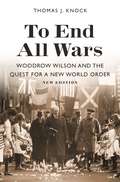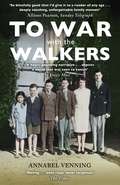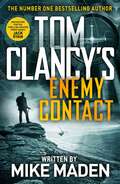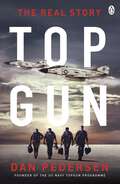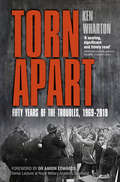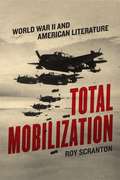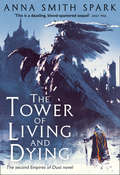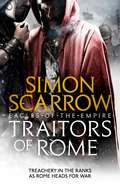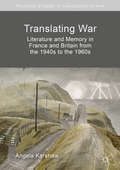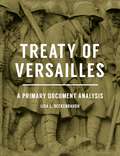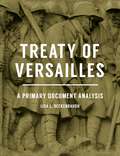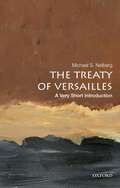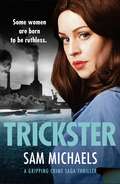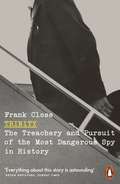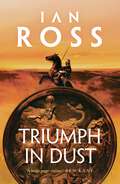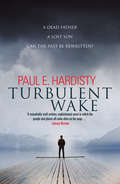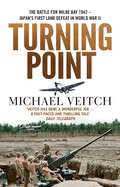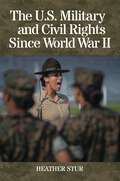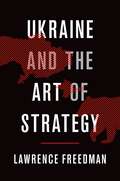- Table View
- List View
To End All Wars, New Edition: Woodrow Wilson and the Quest for a New World Order
by Thomas KnockA close look at Woodrow Wilson’s political thought and international diplomacyIn the widely acclaimed To End All Wars, Thomas Knock provides an intriguing, often provocative narrative of Woodrow Wilson’s epic quest for a new world order. This book follows Wilson’s thought and diplomacy from his policy toward revolutionary Mexico, through his dramatic call for “Peace without Victory” in World War I, to the Senate’s rejection of the League of Nations. Throughout, Knock reinterprets the origins of internationalism in American politics, sweeping away the view that isolationism was the cause of Wilson’s failure and revealing the role of competing visions of internationalism—conservative and progressive.
To War With the Walkers: Three Soldiers, a War Bride, a Nurse and a Doctor: One Family's Extraordinary Story of Survival in the Second World War
by Annabel Venning'A moving book . . . This account of one family's experience takes us to hidden crannies of the war that more official accounts might not bother with . . . Once read, never forgotten.'THE TIMES'A heart-pounding narrative that feels fresh . . . Seeing the war through the Walkers' eyes, you realise what a truly extraordinary generation it was, and how much we owe them.'DAILY MAIL'A sensationally good book . . . I see reflections of my own family, and beyond them, like those mirrors tilted slightly into infinity, I can see literally miles of others lined up, inexorably linked forever by a shared experience . . . this is an exceptional book and should be required reading in modern history classes.'JOANNA LUMLEY~How would it feel if all your sons and daughters were caught up in war?What would it be like to spend six years fearing what a telegram might bring?That was the heart-wrenching reality faced by so many families throughout the Second World War, including the parents of the Walker children. From the Blitz to the battlefields of Europe and the Far East, this is the remarkable story of four brothers and two sisters who were swept along by the momentous events of the war. Harold was a surgeon in a London hospital alongside his sister Ruth, a nurse, when the bombs began to fall in 1940. Peter was captured in the fall of Singapore. Edward fought the Germans in Italy, and Walter the Japanese in Burma, while in London, glamorous Bee hoped for lasting happiness with an American airman. In To War With the Walkers, Annabel Venning, Walter's granddaughter, tells the enthralling and moving tales of her relatives, six ordinary young men and women, who each faced an extraordinary struggle for survival.
Tom Clancy's Enemy Contact (Jack Ryan Jr)
by Mike MadenREAD THE INSPIRATION FOR THE AMAZON PRIME HIT-SERIES JACK RYAN Jack Ryan, Jr's race to stop an international criminal conspiracy is intertwined with the fate of an old friend in this blistering new thriller. On a remote island off the coast of Argentina, a team of elite counter-terror commandos prepare to assault a newly-discovered Hezbollah hideout. What they don't expect is to be brutally ambushed themselves - slaughtered with no survivors. And what they don't realise is that, on screens around the world, the enemies of the West are watching. Back in Washington DC, the growing obstruction in the Senate has reached crippling levels, as a crucial treaty to strength NATO in Eastern Europe is inexplicably blocked.Suspecting that key politicians may have been compromised - but aware of the explosive consequences of making such accusations in public - the President dispatches Jack Ryan Jr to Poland to investigate. In Warsaw, Jack partners with beautiful and brilliant Polish agent Liliana Zaleski, and it's not long before they find evidence of a tangled web of corruption. But what Jack and Liliana don't realise is that this conspiracy stretches further than they could ever have imagined, and the danger has already crept terrifyingly close to home...Praise for Tom Clancy: 'Constantly taps the current world situation for its imminent dangers and spins them into an engrossing tale' New York Times 'Heart-stopping action . . . entertaining and eminently topical' Washington Post'A virtuoso display of page-turning talent' Sunday Express
Topgun: An American Story
by Dan Pedersen"Top Gun" became a household name with the worldwide success of the film of the same title. The 1986 blockbuster starring Tom Cruise as a hotshot U.S. Navy fighter pilot was so popular (drawing $356 million worldwide) that recruiters set up desks in theaters that were showing it, looking to attract the next generation of combat aviators. The movie did for Navy pilots what The Right Stuff did for astronauts.With the 50th anniversary of the establishment of the real TOPGUN-as the U.S. Navy Fighter Weapons program was known-approaching in 2019, and with Jerry Bruckheimer's sequel, Top Gun: Maverick, set to shoot next year, this is the time to publish the real story of the actual risk takers, disruptors, and innovators who revolutionized the art of aerial combat and created the center for excellence and incubator of leadership that thrives to this day.Here is the inside story of TOPGUN, told by the man who was picked to lead it at the start, from war to peace and back to war again, on and off the flight line, and through all six of our decades. Though Pedersen was a part of it at the beginning, some other great pilots carried on our work and he is eager to pay them tribute and make the book a celebration of our whole community. It's a great story, full of interesting characters and exciting history that American should know.
Torn Apart: Fifty Years of the Troubles, 1969-2019
by Ken WhartonAs the fiftieth anniversary of the Troubles approaches, Ken Wharton takes a thorough look at the start of the Troubles, the precursors and the explosion of violence in 1969 that would last until the Good Friday Agreement in 1998 and cost 50,000 casualties and nearly 2,000 civilians’ lives across Northern Ireland, the Republic and England. Utterly condemnatory of the Provisional IRA and their ilk, Wharton pulls no punches in his assessment of the situation then and seeks to dismiss apologists today. His sympathy lies first with those tasked with keeping order in the province, but also with the innocent civilians caught up in thirty years of immense bloodshed. Based on the powerful testimony of those who were there at the time, The Troubles is written with passion and detailed knowledge of the experience of the squaddie.
Total Mobilization: World War II and American Literature
by Roy ScrantonSince World War II, the story of the trauma hero—the noble white man psychologically wounded by his encounter with violence—has become omnipresent in America’s narratives of war, an imaginary solution to the contradictions of American political hegemony. In Total Mobilization, Roy Scranton cuts through the fog of trauma that obscures World War II, uncovering a lost history and reframing the way we talk about war today. Considering often overlooked works by James Jones, Wallace Stevens, Martha Gellhorn, and others, alongside cartoons and films, Scranton investigates the role of the hero in industrial wartime, showing how such writers struggled to make sense of problems that continue to plague us today: the limits of American power, the dangers of political polarization, and the conflicts between nationalism and liberalism. By turning our attention to the ways we make war meaningful—and by excavating the politics implicit within the myth of the traumatized hero—Total Mobilization revises the way we understand not only World War II, but all of postwar American culture.
Total Mobilization: World War II and American Literature
by Roy ScrantonSince World War II, the story of the trauma hero—the noble white man psychologically wounded by his encounter with violence—has become omnipresent in America’s narratives of war, an imaginary solution to the contradictions of American political hegemony. In Total Mobilization, Roy Scranton cuts through the fog of trauma that obscures World War II, uncovering a lost history and reframing the way we talk about war today. Considering often overlooked works by James Jones, Wallace Stevens, Martha Gellhorn, and others, alongside cartoons and films, Scranton investigates the role of the hero in industrial wartime, showing how such writers struggled to make sense of problems that continue to plague us today: the limits of American power, the dangers of political polarization, and the conflicts between nationalism and liberalism. By turning our attention to the ways we make war meaningful—and by excavating the politics implicit within the myth of the traumatized hero—Total Mobilization revises the way we understand not only World War II, but all of postwar American culture.
Total Mobilization: World War II and American Literature
by Roy ScrantonSince World War II, the story of the trauma hero—the noble white man psychologically wounded by his encounter with violence—has become omnipresent in America’s narratives of war, an imaginary solution to the contradictions of American political hegemony. In Total Mobilization, Roy Scranton cuts through the fog of trauma that obscures World War II, uncovering a lost history and reframing the way we talk about war today. Considering often overlooked works by James Jones, Wallace Stevens, Martha Gellhorn, and others, alongside cartoons and films, Scranton investigates the role of the hero in industrial wartime, showing how such writers struggled to make sense of problems that continue to plague us today: the limits of American power, the dangers of political polarization, and the conflicts between nationalism and liberalism. By turning our attention to the ways we make war meaningful—and by excavating the politics implicit within the myth of the traumatized hero—Total Mobilization revises the way we understand not only World War II, but all of postwar American culture.
Total Mobilization: World War II and American Literature
by Roy ScrantonSince World War II, the story of the trauma hero—the noble white man psychologically wounded by his encounter with violence—has become omnipresent in America’s narratives of war, an imaginary solution to the contradictions of American political hegemony. In Total Mobilization, Roy Scranton cuts through the fog of trauma that obscures World War II, uncovering a lost history and reframing the way we talk about war today. Considering often overlooked works by James Jones, Wallace Stevens, Martha Gellhorn, and others, alongside cartoons and films, Scranton investigates the role of the hero in industrial wartime, showing how such writers struggled to make sense of problems that continue to plague us today: the limits of American power, the dangers of political polarization, and the conflicts between nationalism and liberalism. By turning our attention to the ways we make war meaningful—and by excavating the politics implicit within the myth of the traumatized hero—Total Mobilization revises the way we understand not only World War II, but all of postwar American culture.
Total Mobilization: World War II and American Literature
by Roy ScrantonSince World War II, the story of the trauma hero—the noble white man psychologically wounded by his encounter with violence—has become omnipresent in America’s narratives of war, an imaginary solution to the contradictions of American political hegemony. In Total Mobilization, Roy Scranton cuts through the fog of trauma that obscures World War II, uncovering a lost history and reframing the way we talk about war today. Considering often overlooked works by James Jones, Wallace Stevens, Martha Gellhorn, and others, alongside cartoons and films, Scranton investigates the role of the hero in industrial wartime, showing how such writers struggled to make sense of problems that continue to plague us today: the limits of American power, the dangers of political polarization, and the conflicts between nationalism and liberalism. By turning our attention to the ways we make war meaningful—and by excavating the politics implicit within the myth of the traumatized hero—Total Mobilization revises the way we understand not only World War II, but all of postwar American culture.
Total Mobilization: World War II and American Literature
by Roy ScrantonSince World War II, the story of the trauma hero—the noble white man psychologically wounded by his encounter with violence—has become omnipresent in America’s narratives of war, an imaginary solution to the contradictions of American political hegemony. In Total Mobilization, Roy Scranton cuts through the fog of trauma that obscures World War II, uncovering a lost history and reframing the way we talk about war today. Considering often overlooked works by James Jones, Wallace Stevens, Martha Gellhorn, and others, alongside cartoons and films, Scranton investigates the role of the hero in industrial wartime, showing how such writers struggled to make sense of problems that continue to plague us today: the limits of American power, the dangers of political polarization, and the conflicts between nationalism and liberalism. By turning our attention to the ways we make war meaningful—and by excavating the politics implicit within the myth of the traumatized hero—Total Mobilization revises the way we understand not only World War II, but all of postwar American culture.
The Tower of Living and Dying (Empires of Dust #2)
by Anna Smith SparkKING OF RUIN. KING OF DUST AND SHADOWS. KING OF DEATH. HE WILL RULE ALL. THE KING IS COMING.
Traitors of Rome: Treachery In The Ranks As Rome Heads For War (Eagles Of The Empire Ser.)
by Simon ScarrowThe enthralling new Cato and Macro adventure in Simon Scarrow's bestselling Eagles of the Empire series. Not to be missed by readers of Conn Iggulden and Bernard Cornwell. AD 56. Battle-hardened veterans of the Roman army Tribune Cato and Centurion Macro are garrisoned at the eastern border, aware that their movements are constantly monitored by spies from dangerous, mysterious Parthia. But the enemy within could be the deadliest threat to the Legion ... and the Empire. There's a traitor in the ranks. Rome shows no mercy to those who betray their comrades, and the Empire. But first the guilty man must be discovered. Cato and Macro are in a race against time to expose the truth, while the powerful enemy over the border waits to exploit any weaknesses in the Legion. The traitor must die ... Praise for Simon Scarrow's bestselling novels: 'Blood, gore, political intrigue...A historical fiction thriller that'll have you reaching for your gladius' Daily Sport'Gripping... ferocious and compelling' Daily Express'Brilliantly told adventures ... Roman soldiering at its very best - even by Scarrow's high standards' Sunday Sport
Translating War: Literature and Memory in France and Britain from the 1940s to the 1960s (Palgrave Studies in Languages at War)
by Angela KershawThis book examines the role played by the international circulation of literature in constructing cultural memories of the Second World War. War writing has rarely been read from the point of view of translation even though war is by definition a multilingual event, and knowledge of the Second World War and the Holocaust is mediated through translated texts. Here, the author opens up this field of research through analysis of several important works of French war fiction and their English translations. The book examines the wartime publishing structures which facilitated literary exchanges across national borders, the strategies adopted by translators of war fiction, the relationships between translated war fiction and dominant national memories of the war, and questions of multilingualism in war writing. In doing so, it sheds new light on the political and ethical questions that arise when the trauma of war is represented in fiction and through translation. This engaging work will appeal to students and scholars of translation, cultural memory, war fiction and Holocaust writing.
Treaty of Versailles: A Primary Document Analysis
by Lisa L. BeckenbaughAn indispensable resource on the Treaty of Versailles, one of the most influential and controversial documents in history, this book explains how the treaty tried to solve the complex issues that emerged from the destruction of World War I.This carefully curated primary source collection includes roughly 60 documents related to the signing of the Treaty of Versailles. By collecting all of the most significant documents in one volume, it allows readers to hear the original arguments surrounding the treaty and to explore the voices of the people involved at the Paris Peace Conference. Moreover, it allows readers to engage with the documents so as to better understand the complex motivations and issues coming out of World War I and highlights the differences between the victors and identifies the problems many countries had with the treaty before it was even signed.The documents are organized in chronological order, providing a blueprint to help students to understand all of the significant events that led to the treaty, as well as the vast repercussions of the treaty itself. In addition to the Treaty of Versailles itself, documents include such significant primary sources as the Sykes-Picot Agreement, the Balfour Declaration, the Treaty of Brest-Litovsk, President Woodrow Wilson's Fourteen Points, and Germany's response to the treaty.
Treaty of Versailles: A Primary Document Analysis
by Lisa L. BeckenbaughAn indispensable resource on the Treaty of Versailles, one of the most influential and controversial documents in history, this book explains how the treaty tried to solve the complex issues that emerged from the destruction of World War I.This carefully curated primary source collection includes roughly 60 documents related to the signing of the Treaty of Versailles. By collecting all of the most significant documents in one volume, it allows readers to hear the original arguments surrounding the treaty and to explore the voices of the people involved at the Paris Peace Conference. Moreover, it allows readers to engage with the documents so as to better understand the complex motivations and issues coming out of World War I and highlights the differences between the victors and identifies the problems many countries had with the treaty before it was even signed.The documents are organized in chronological order, providing a blueprint to help students to understand all of the significant events that led to the treaty, as well as the vast repercussions of the treaty itself. In addition to the Treaty of Versailles itself, documents include such significant primary sources as the Sykes-Picot Agreement, the Balfour Declaration, the Treaty of Brest-Litovsk, President Woodrow Wilson's Fourteen Points, and Germany's response to the treaty.
The Treaty of Versailles: A Very Short Introduction (Very Short Introductions)
by Michael S. NeibergSigned on June 28, 1919 between Germany and the principal Allied powers, the Treaty of Versailles formally ended World War I. Problematic from the very beginning, even its contemporaries saw the treaty as a mediocre compromise, creating a precarious order in Europe and abroad and destined to fall short of ensuring lasting peace. At the time, observers read the treaty through competing lenses: a desire for peace after five years of disastrous war, demands for vengeance against Germany, the uncertain future of colonialism, and, most alarmingly, the emerging threat of Bolshevism. A century after its signing, we can look back at how those developments evolved through the twentieth century, evaluating the treaty and its consequences with unprecedented depth of perspective. The author of several award-winning books, Michael S. Neiberg provides a lucid and authoritative account of the Treaty of Versailles, explaining the enormous challenges facing those who tried to put the world back together after the global destruction of the World War I. Rather than assessing winners and losers, this compelling book analyzes the many subtle factors that influenced the treaty and the dominant, at times ambiguous role of the "Big Four" leaders: Woodrow Wilson of the United States, David Lloyd George of Great Britain, Vittorio Emanuele Orlando of Italy, and Georges Clémenceau of France. The Treaty of Versailles was not solely responsible for the catastrophic war that crippled Europe and the world just two decades later, but it played a critical role. As Neiberg reminds us, to understand decolonization, World War II, the Cold War, and even the complex world we inhabit today, there is no better place to begin than with World War I and the treaty that tried, and perhaps failed, to end it. ABOUT THE SERIES: The Very Short Introductions series from Oxford University Press contains hundreds of titles in almost every subject area. These pocket-sized books are the perfect way to get ahead in a new subject quickly. Our expert authors combine facts, analysis, perspective, new ideas, and enthusiasm to make interesting and challenging topics highly readable.
Trickster (Georgina Garrett Series #1)
by Sam Michaels'Sam Michaels is an exciting new author and Trickster is a must-read! Captivating and fast-paced, this first book in the Georgina Garrett series is a real page-turner that I highly recommend' Sunday Times bestselling author, Kitty Neale. Georgina Garrett was born to be ruthless and she's about to earn her reputation. As World War One is announced a baby girl is born. Little do people know that she's going to grow up to rule the streets of Battersea. From a family steeped in poverty the only way to survive is with street smarts. With a father who steals for a living, a grandmother who's a woman of the night and a mother long dead, Georgina was never in for an easy life. But after a tragic event left her father shaken he makes a decision that will change the course of all their lives – to raise Georgina as George, ensuring her safety but marking the start of her life of crime... This is the first book in the thrilling new Georgina Garrett series. Praise for Trickster: 'A terrific debut – read it and be hooked!' Jessie Keane, bestselling author of Lawless.
Trinity: The Treachery and Pursuit of the Most Dangerous Spy in History
by Frank Close'Everything about this story is astounding' Bryan Appleyard, Sunday Times"Trinity" was the codename for the test explosion of the atomic bomb in New Mexico on 16 July 1945. Trinity is now also the extraordinary story of the bomb's metaphorical father, Rudolf Peierls; his intellectual son, the atomic spy, Klaus Fuchs, and the ghosts of the security services in Britain, the USA and USSR.Against the background of pre-war Nazi Germany, the Second World War and the following Cold War, the book traces how Peierls brought Fuchs into his family and his laboratory, only to be betrayed. It describes in unprecedented detail how Fuchs became a spy, his motivations and the information he passed to his Soviet contacts, both in the UK and after he went with Peierls to join the Manhattan Project at Los Alamos in 1944. Frank Close is himself a distinguished nuclear physicist: uniquely, the book explains the science as well as the spying.Fuchs returned to Britain in August 1946 still undetected and became central to the UK's independent effort to develop nuclear weapons. Close describes the febrile atmosphere at Harwell, the nuclear physics laboratory near Oxford, where many of the key players were quartered, and the charged relationships which developed there. He uncovers fresh evidence about the role of the crucial VENONA signals decryptions, and shows how, despite mistakes made by both MI5 and the FBI, the net gradually closed around Fuchs, building an intolerable pressure which finally cracked him.The Soviet Union exploded its first nuclear device in August 1949, far earlier than the US or UK expected. In 1951, the US Congressional Committee on Atomic Espionage concluded, 'Fuchs alone has influenced the safety of more people and accomplished greater damage than any other spy not only in the history of the United States, but in the history of nations'. This book is the most comprehensive account yet published of these events, and of the tragic figure at their centre.
Triumph in Dust (Twilight of Empire #6)
by Ian RossFerocity, heroism, and savage bloodshed: the next gripping instalment in the Twilight of Empire series. For fans of Ben Kane and Conn Iggulden. When the simmering conflict between Rome and Persia threatens to reignite into open war, there is only one man the Emperor Constantine can trust to hold the eastern frontier. Aurelius Castus, retired general of the empire, has fought long and hard for Rome. When the summons comes to command an army once more, he obeys with a heavy heart. But is he still the fearsome fighting machine of old? As tragedy strikes the imperial household, Castus must race to defend the last bulwark standing against the might of Persia. Castus knows that the fight ahead will be the fiercest he has ever known, and will very probably be his last. 'I was immersed from the very first page. Wonderful writing. Rich and evocative, astute and assured. Great stuff!' Giles Kristian, bestselling author of Lancelot.
Turbulent Wake
by Paul E. HardistyA stark, eye-opening and exquisitely poignant new novel spanning the globe and probing the issues that define our times. As a young man comes to terms with his father’s death, he is forced to face his own demons, and confront the possibility of change…‘This is a remarkably well-written, sophisticated novel in which the people and places all come alive on the page…’ Literary Review‘Searing … at times achieves the level of genuine poetry’ Publishers WeeklyEthan Scofield returns to the place of his birth to bury his father. Hidden in one of the upstairs rooms of the old man’s house he finds a strange manuscript, a collection of stories that seems to cover the whole of his father’s turbulent life.As his own life starts to unravel, Ethan works his way through the manuscript, trying to find answers to the mysteries that have plagued him since he was a child. What happened to his little brother? Why was his mother taken from him?And why, in the end, when there was no one else left, did his own father push him away?Swinging from the coral cays of the Caribbean to the dangerous deserts of Yemen and the wild rivers of Africa, Turbulent Wake is a bewitching, powerful and deeply moving story of love and loss … of the indelible damage we do to those closest to us and, ultimately, of the power of redemption in a time of change.‘The quality of Hardisty’s writing and the underlying truth of his plots sets this above many other thrillers’ West Australia‘Turbulent Wake is moving, it caused me to ache deep inside, oh, and it is also a rather beautiful read too’ LoveReading‘The writing is sublime! SO different from the Claymore Straker series but just as compelling - a round-the-world journey through a lifetime of regrets. Wow!’ Off-the-Shelf Books‘If you like literary fiction with heart then you MUST read the stunning Turbulent Wake – powerful, evocative, profound; I savoured every word’ Karen Cole‘Turbulent Wake is a truly beautiful story … what a special book this is’ Jen Meds Book Reviews‘Evocative, compelling, a pull-at-your-heartstrings page turning read! A book that you will absorb into your very soul! Go and get a copy today!’ Crime Book Junkie‘Turbulent Wake is a beautifully written and atmospheric read that will stay with me for a long time … The author’s vivid descriptions are wonderful and I felt like I had a fly on the wall view of everything that was happening’ Over the Rainbow Book Blog‘Powerful, evocative, profound; I savoured every word’ Hair Past a Freckle‘Compelling and inspiring, it is an adventure, a journey, a exploration of life, a fascinating novel’ Swirl & Thread‘Heartbreaking, honest, wonderful. This novel needs to be read by many, so they can see what damage they cause’ Steph’s Book Blog
Turning Point: The Battle for Milne Bay 1942 - Japan's first land defeat in World War II
by Michael VeitchSeptember 1942 marked the high-point of Axis conquest in World War II. In the Pacific, Japan's soldiers had seemed unstoppable. However, the tide was about to turn.On Sunday, 6 September 1942, Japanese land forces suffered their first conclusive defeat at the hands of the Allies. At Milne Bay in Papua New Guinea, a predominantly Australian force - including 75 Squadron (fresh from their action in 44 Days) - fought for two weeks to successfully defend a vital airstrip against a determined Japanese invasion. The victorious Australian army units were crucially supported by two locally-based squadrons of RAAF Kittyhawks.The Battle for Milne Bay and victory for the Allies was a significant turning point in the Pacific War, but while it received worldwide publicity at the time, it has since been largely forgotten... It deserves to be remembered. Michael Veitch, actor, presenter and critically acclaimed author, brings to life the incredible exploits and tragic sacrifices of these Australian heroes in another fast-paced and thrilling tale.
The U.S. Military and Civil Rights Since World War II
by Heather SturThrough examinations of U.S. military racial and gender integration efforts and its handling of sexuality, this book argues that the need for personnel filling the ranks has forced the armed services to be pragmatically progressive since World War II.The integration of African Americans and women into the United States Armed Forces after World War II coincided with major social movements in which marginalized civilians demanded equal citizenship rights. As this book explores, due to personnel needs, the military was a leading institution in its opening of positions to women and African Americans and its offering of educational and economic opportunities that in many cases were not available to them in the civilian world. By opening positions to African Americans and women and remaking its "where boys become men" image, the military was an institutional leader on the issue of social equality in the second half of the 20th century. The pushback against gay men and women wishing to serve openly in the forces, however, revealed the limits of the military's pragmatic progressivism. This text investigates how policymakers have defined who belongs in the military and counts as a soldier, and examines how the need to attract new recruits led to the opening of the forces to marginalized groups and the rebranding of the services.
The U.S. Military and Civil Rights Since World War II
by Heather SturThrough examinations of U.S. military racial and gender integration efforts and its handling of sexuality, this book argues that the need for personnel filling the ranks has forced the armed services to be pragmatically progressive since World War II.The integration of African Americans and women into the United States Armed Forces after World War II coincided with major social movements in which marginalized civilians demanded equal citizenship rights. As this book explores, due to personnel needs, the military was a leading institution in its opening of positions to women and African Americans and its offering of educational and economic opportunities that in many cases were not available to them in the civilian world. By opening positions to African Americans and women and remaking its "where boys become men" image, the military was an institutional leader on the issue of social equality in the second half of the 20th century. The pushback against gay men and women wishing to serve openly in the forces, however, revealed the limits of the military's pragmatic progressivism. This text investigates how policymakers have defined who belongs in the military and counts as a soldier, and examines how the need to attract new recruits led to the opening of the forces to marginalized groups and the rebranding of the services.
Ukraine and the Art of Strategy
by Lawrence FreedmanThe Russian invasion of Crimea in 2014, subsequent war in Eastern Ukraine and economic sanctions imposed by the West, transformed European politics. These events marked a dramatic shift away from the optimism of the post-Cold War era. The conflict did not escalate to the levels originally feared but nor was either side able to bring it to a definitive conclusion. Ukraine suffered a loss of territory but was not forced into changing its policies away from the Westward course adopted as a result of the EuroMaidan uprising of February 2014. President Putin was left supporting a separatist enclave as Russia's economy suffered significant damage. In Ukraine and the Art of Strategy, Lawrence Freedman-author of the landmark Strategy: A History-provides an account of the origins and course of the Russia-Ukraine conflict through the lens of strategy. Freedman describes the development of President Putin's anxieties that former Soviet countries were being drawn towards the European Union, the effective pressure he put on President Yanokvych of Ukraine during 2013 to turn away from the EU and the resulting 'EuroMaidan Revolution' which led to Yanukovych fleeing. He explores the reluctance of Putin to use Russian forces to do more that consolidate the insurgency in Eastern Ukraine, the failure of the Minsk peace process and the limits of the international response. Putin's strategic-making is kept in view at all times, including his use of 'information warfare' and attempts to influence the American election. In contrast to those who see the Russian leader as a master operator who catches out the West with bold moves Freedman sees him as impulsive and so forced to improvise when his gambles fail. Freedman's application of his strategic perspective to this supremely important conflict challenges our understanding of some of its key features and the idea that Vladimir Putin is unmatched as a strategic mastermind.
